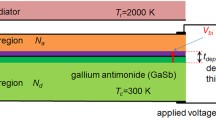Abstract
This article presents a one-dimensional two-temperature hydrodynamic model to study the thermal and electrical behavior of a gallium arsenide (GaAs) PN junction solar cell. This model treats both electron and heat transfer on equal footing and includes Gauss’s law, continuity and momentum equations for electrons and holes, and energy balance using temperature for both carriers and lattice. A zero-order system of equations is obtained using asymptotic series expansions based on the electron Reynolds number for steady-state conditions. An iterative scheme is implemented to solve the zero-order system. The results show the influence of carriers and lattice temperatures in the electrical performance of a GaAs PN junction solar cell. Higher values of power output are obtained with low lattice temperature and hot energy carriers. This modeling contributes to improve the thermal control in photovoltaic technologies.
Similar content being viewed by others
References
Royne A., Dey C.J., Mills D.R.: Cooling of photovoltaic cells under concentrated illumination: a critical review. Sol. Energy Mater. Sol. Cells 86, 451–483 (2005)
De Vos A.: Detailed balance limit of the efficiency of tandem solar cells. J. Appl. Phys. 13, 839–846 (1980)
Luque, A., Marti, A.: Theoretical limits of photovoltaic energy conversion. In: Handbook of Photovoltaic Science and Engineering, Wiley (2011)
Shur M.: Introduction to Electronic Devices. Wiley, New York (1996)
Sze S.M.: Semiconductor Devices, Physics and Technology. Wiley, New York (2002)
Lin A.S., Phillips J.D.: Drift–diffusion modeling for impurity photovoltaic devices. IEEE Trans. Electron Devices 56, 3168–3174 (2009)
Nelson J.: The Physics of Solar Cells. Imperial College Press, London (2003)
Blotekjaer K.: Transport equations for electrons in two-valley semiconductors. IEEE Trans. Electron Devices 17, 38–47 (1970)
Majumdar A., Fushinobu K., Hijikata K.: Effect of gate voltage on hot-electron and hot-phonon interaction and transport in a submicrometer transistor. J. Appl. Phys. 77, 6686–6694 (1995)
Ballestra L., Micheletti S., Sacco R.: Semiconductor device simulation using a viscous-hydrodynamic model. Comput. Methods Appl. Mech. Eng. 191, 5447–5466 (2002)
Jüngel A., Tang S.: A relaxation scheme for the hydrodynamic equations for semiconductors. Appl. Numer. Math. 43, 229–252 (2002)
de Falco, C., Sacco, R., Scrofani, G.: Stabilized 3D finite elements for the numerical solution of the Navier-Stokes equations in semiconductors. Compu. Methods Appl. Mech. Eng. 196, 1729–1744 (2007)
Romano V., Rusakov A.: 2d numerical simulations of an electron–phonon hydrodynamical model based on the maximum entropy principle. Comput. Methods Appl. Mech. Eng. 199, 2741–2751 (2010)
Calderón-Muñoz, W., Sen M., Jena D.: Hydrodynamic instability of one-dimensional electron flow in ungated semiconductors. J. Appl. Phys. 102, 0237034 (2007)
Calderón-Muñoz W., Jena D., Sen M.: Hydrodynamic instability of confined two-dimensional electron flow in semiconductors. J. Appl. Phys. 106, 0145064 (2009)
Abrarov R.M., Sherman E.Y., Sipe J.E.: Hydrodynamic model for relaxation of optically injected currents in quantum wells. Appl. Phys. Lett. 91, 232113 (2007)
Sherman E.T., Abrarov R.M., Sipe J.E.: Dynamics of optically injected two-dimensional currents. J. Appl. Phys. 104, 103701 (2008)
Mohseni K., Shakouri A., Ranm R.J., Abraham M.C.: Electron vortices in semiconductors devices. Phys. Fluids 17, 100602 (2005)
Chen G.: Potential-step amplified nonequilibrium thermal-electric converters. J. Appl. Phys. 97, 1–9 (2005)
Calderón-Muñoz W., Jena D., Sen M.: Thermal influence on hydrodynamic instabilities in a one-dimensional electron flow in semiconductors. J. Appl. Phys. 107, 0745044 (2010)
Osses-Márquez J., Calderón-Muñoz W.: Thermal influence on charge carrier transport in solar cells based on GaAs PN junctions. J. Appl. Phys. 116, 154502 (2014)
Kim J.P., Lim H., Song J.H., Chang Y.J., Jeon C.H.: Numerical analysis on the thermal characteristics of photovoltaic module with ambient temperature variation. Sol. Energy Mater. Sol. Cells 95, 404–407 (2011)
Holmes M.H.: Introduction to Perturbation Methods. Springer, New York (1995)
Goodnick, S.M., Honsberg, C.: Ultrafast carrier relaxation and nonequilibrium phonons in hot carrier solar cells. In: Photovoltaic Specialists Conference (PVSC) IEEE, 2011 37th IEEE, 002066–002070, (2011)
Beard M.C., Ellingson R.J.: Multiple exciton generation in semiconductor nanocrystals: toward efficient solar energy conversion. Laser Photon. Rev. 25, 377–399 (2008)
Bissels G.M.M.W., Asselbergs M.A.H., Bauhuis G.J., Mulder P., Haverkamp E.J., Vlieg E., Schermer J.J.: Anomalous IV-characteristics of a GaAs solar cell under high irradiance. Sol. Energy Mater. Sol. Cells 104, 97–101 (2012)
Nishioka K., Takamoto T., Agui T., Kaneiwa M., Uraoka Y., Fuyuki T.: Evaluation of temperature characteristics of high-efficiency InGaP/InGaAs/Ge triple-junction solar cells under concentration. Sol. Energy Mater. Sol. Cells 85, 429–436 (2005)
Feteha M.Y., Eldallal G.M.: The effects of temperature and light concentration on the GaInP/GaAs multijunction solar cells performance. Renew. Energy 28, 1097–1104 (2003)
Nishioka K., Takamoto T., Agui T., Kaneiwa M., Uraoka Y., Fuyuki T.: Annual output estimation of concentrator photovoltaic systems using high-efficiency InGaP/InGaAs/Ge triple-junction solar cells based on experimental solar cells characteristics and field-test meteorological data. Sol. Energy Mater. Sol. Cells 90, 57–67 (2006)
Author information
Authors and Affiliations
Corresponding author
Rights and permissions
About this article
Cite this article
Calderón-Muñoz, W.R., Jara-Bravo, C. Hydrodynamic modeling of hot-carrier effects in a PN junction solar cell. Acta Mech 227, 3247–3260 (2016). https://doi.org/10.1007/s00707-015-1538-5
Received:
Revised:
Published:
Issue Date:
DOI: https://doi.org/10.1007/s00707-015-1538-5




